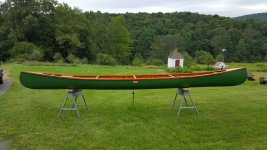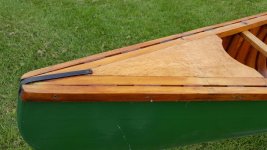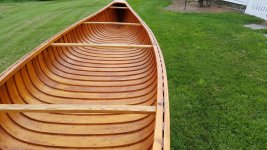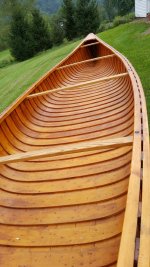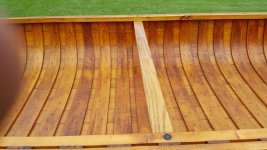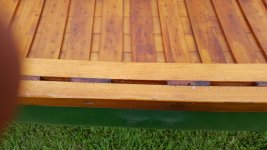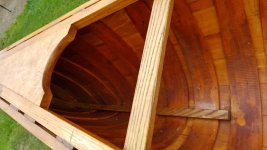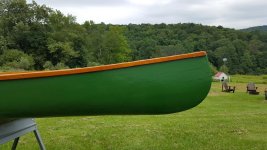I have an unidentified w/c canoe. In describing it to someone where are measurments taken from overall ? The bow & stern ends of the gunnels or the furthermost distance at the stembands ? Is the width at the inwales or outwales or tumblehome and the depth to the ribs or planking ?
-
Happy National Garlic Day! 🧄🚫🧛🏼♂️
You are using an out of date browser. It may not display this or other websites correctly.
You should upgrade or use an alternative browser.
You should upgrade or use an alternative browser.
question ? how to measure a canoe?
- Thread starter forest runes
- Start date
I never know so what I do is take a measurement and add a description of how that measurement came to be-like this:
16' 4" from top of stem to top of stem
16'10" from longest point on stem to longest point on opposite stem
or 13" deep from top of plank to top of center gunnel (which would be the underside of the inwale)
or you could lay a board across the gunnels and say: 14" from top of plank to top of gunnell.
I always measure the width from inside the plank to inside the plank at widest point and mention that : 30 1/2 inches inside plank to inside plank at widest point
Not sure if this is of any help, maybe someone else knows the correct and standard way of measuring all canoes.
16' 4" from top of stem to top of stem
16'10" from longest point on stem to longest point on opposite stem
or 13" deep from top of plank to top of center gunnel (which would be the underside of the inwale)
or you could lay a board across the gunnels and say: 14" from top of plank to top of gunnell.
I always measure the width from inside the plank to inside the plank at widest point and mention that : 30 1/2 inches inside plank to inside plank at widest point
Not sure if this is of any help, maybe someone else knows the correct and standard way of measuring all canoes.
- Joined
- Mar 20, 2013
- Messages
- 3,356
- Reaction score
- 475
I don'T thing there is a standard way... Just like rocker, no one mesure rocker a the same place... A canoe that is advertise as 3" rocker might only be advertised as 2" by some one else!! I like Robin's ways of describing things... that way there canot be mistakes!!
Has anyone checked a known model against a mfgs. spec table. I wonder what kind of tolerance was acceptable. I'm sure there was a variance in weight.
Don't know what's official but for length I like to put the canoe upright on a couple of saw horses -go straight down from the farthest out point at each end and then measure the distance between those 2 points. For width I measure inside hull to inside hull, for a symmetrical canoe this is usually also the width of the yoke.
- Joined
- Jun 30, 2014
- Messages
- 1,550
- Reaction score
- 282
Ohhhh cool. I love UFO's ( unidentified floating objects). Lots of fun trying to source out what it is. Get some pictures up with some specs and a serial number if it has one and we can ponder the lineage. Decks are key.
I generally measure longest point of the boat, plank to plank for width and planking to top of gunwales for depth. And no, there is not really a rigid adherence to specs as they were still mostly hand made and that occasioned a degree of variation in the manufacturing tolerances. Plus people put narrower thwarts on them, or wider, or let it sit without seats and the tumblehome relaxes etc etc. 16 feet is not necessarily spot on 16 feet either...more of an ish thing. We have seen all manner of thuggery committed on some previously nice boats.
Get that camera out and lets go.
Christy
I generally measure longest point of the boat, plank to plank for width and planking to top of gunwales for depth. And no, there is not really a rigid adherence to specs as they were still mostly hand made and that occasioned a degree of variation in the manufacturing tolerances. Plus people put narrower thwarts on them, or wider, or let it sit without seats and the tumblehome relaxes etc etc. 16 feet is not necessarily spot on 16 feet either...more of an ish thing. We have seen all manner of thuggery committed on some previously nice boats.
Get that camera out and lets go.
Christy
Thanks for the offer Iskweo, I am somewhat of a luddite when it comes to photos & posting them but I will get them together. This canoe has no serial # but some odd features. It has never been used except by myself, the former owner won it in a raffle in northern Canada (so the story goes ) back in the seventies put in in his garage & never used it ,I cannot get in touch with him so cannot get further info. It is +- 20', no seats except a wood slat catbird seat in the stern, expertly constructed of red cedar with spruce gunnels & straight ash thwarts but paint over canvas with no filler somewhat roughly done, robertson screws and aluminum (?) stem bands. Will get photos together & post them. Thanks for the help !
Last edited:
Just use the little camera icon and upload directly from your computer. We cant wait.. Is this the boat you will be taking on the West Branch?
Yes, I've taken it out on smaller lakes for test runs, extremely fast & easy to control but it is enormously heavy for me. So can only use it with a partner . Closest measurements seem to be a chestnut voyager but no mfg. marks. appeciate the help guys
No Title
Here are photos, the bride helped me to upload them ! Also some additional info : 39" wide outwale to outwale ,12" deep top of gunnel to ribs amidship , 20' stem to stem , 3" ribs with 1" space between.
Here are photos, the bride helped me to upload them ! Also some additional info : 39" wide outwale to outwale ,12" deep top of gunnel to ribs amidship , 20' stem to stem , 3" ribs with 1" space between.
Attachments
After reading about riverie's canoe , I went out and put a magnet next to gunnel screws & bolts and stem bands all steel , deck seems to be birdseye maple . The built in ash slat seat is far to the stern and tight to the gunnels , but it had two folding spruce slat seats. Should I think about replacing steel hardware ?
I would replace while you have the opportunity. If the canoe has Robertson screws, Jamestown Distributors carries silicon bronze Robertsons.After reading about riverie's canoe , I went out and put a magnet next to gunnel screws & bolts and stem bands all steel , deck seems to be birdseye maple . The built in ash slat seat is far to the stern and tight to the gunnels , but it had two folding spruce slat seats. Should I think about replacing steel hardware ?
Mike Elliott ( Author of " this Old Canoe" ) was gracious enough to make a conjecture on this canoe. While He could not ID the builder , he seemed to think it was purpose built as a working salmon guide fishing canoe. Very pleasant & knowledgeable fellow who I met at the WCHA assembly this year. Very informative book for us who love W/C canoes but need info on their maintenance and repair.
Christy is still out in the bush so she will comment later I'm sure. Basic, flat, tapered ribs, shallow with no tumble home. Not that I have Mike Elliot's expertise, but it would seem to perhaps be a one off personal boat. Could be good for poling, with that flat floor. Nice boat regardless. My Chestnut built in the 60's had Aluminium stem bands.
Steel is fine if you keep it indoors always. I usually order silicon bronze from the US of A but it is getting pricey with how low our dollar is. I may need to ask a friend to order some on the East coast and ship them to me since my usual supplier stopped carrying the longer 10/24 carriage bolts I like.
Karin
Steel is fine if you keep it indoors always. I usually order silicon bronze from the US of A but it is getting pricey with how low our dollar is. I may need to ask a friend to order some on the East coast and ship them to me since my usual supplier stopped carrying the longer 10/24 carriage bolts I like.
Karin
Mihun, What do you make of while obviously this wasn't his first build (unless he was very talented ),why did he paint the canvas directly with no filler? These boats stay inside the barn , royalex to the rear . I might think about replacing the gunnel screws & bolts but not the stem band I'd be afraid of tempting fate ( shes dry as a bone now ), So I may be placing an order once I acertain if the cure is worst than the disease .
Last edited:
I know you can get plans for a one off mould for w/c canoes, Doug Ingram sells them. So, it could be a one off, or maybe a small operation. The previous owner won it in a raffle in Northern Canada, Or, it was a canoe made in Northern Canada that was won in a raffle? Kildonan made canoes in Winnipeg until a fire in the 70's but the only Kildonan that has come through our shop was an 18 foot Y stern. Plenty of other smaller operations as well making a half dozen boats a year, mostly no longer in business. Anything that old could be impossible to track to original manufacture.
The lack of filler on the canvas is certainly odd. Back then, hard to say if they even knew about filling it first. Lack of internet amongst other things. Must be a lot of paint on the canvas if it does not leak without filler, or, perhaps the canvas has been replaced since.
It is always fun after replacing canvas to drill through it for new stem bands, although the majority of the new screws are above the waterline. This is likely one reason we never put a keel back on a boat after restoration. Why tempt fate by drilling another 20 odd holes through the canvas.
The lack of filler on the canvas is certainly odd. Back then, hard to say if they even knew about filling it first. Lack of internet amongst other things. Must be a lot of paint on the canvas if it does not leak without filler, or, perhaps the canvas has been replaced since.
It is always fun after replacing canvas to drill through it for new stem bands, although the majority of the new screws are above the waterline. This is likely one reason we never put a keel back on a boat after restoration. Why tempt fate by drilling another 20 odd holes through the canvas.
Those wide close ribs and setup sure make it look like one of the Chestnut Ogilvy salmon fishing canoes. I recall reading that some of the Chestnut forms were purchased by some Native groups after Chestnut closed up shop in the late 70s. Some of these bands tried building canoes on their reserves as a business before stopping and declaring bankruptcy a few years later too. Perhaps this is one of those canoes from that transition era?
As for the absence of filler, Garth Taylor documented a Cree builder from northern Quebec in 1980 using canvas as a substitute for birchbark. He noted that the Cree community had a long tradition of using canvas on their canoes and simply waterproofing with thick layers of paint. Earlier, Tappan Adney documented other native groups using painted canvas in their canoes so there is a history of avoiding filler. The canvas would degrade and need to be replaced every few years after hard usage, but both authors noted it was a pretty simple job to do and less expensive to just paint. No waiting weeks for the filler to cure, etc.
As for the absence of filler, Garth Taylor documented a Cree builder from northern Quebec in 1980 using canvas as a substitute for birchbark. He noted that the Cree community had a long tradition of using canvas on their canoes and simply waterproofing with thick layers of paint. Earlier, Tappan Adney documented other native groups using painted canvas in their canoes so there is a history of avoiding filler. The canvas would degrade and need to be replaced every few years after hard usage, but both authors noted it was a pretty simple job to do and less expensive to just paint. No waiting weeks for the filler to cure, etc.
Murat, these days some builders are also trying other waterproofing techniques to avoid the wait time for a more traditional filler. I've heard of basement waterproofing sealer, some use epoxy resin, others latex paint, one uses drywall compound and still, there is the Gluvit epoxy being used amongst other concoctions. We still use silica sand based filler but have done experiments on canvas pieces with polyester and epoxy resins, to see which is best at not soaking through the canvas and attaching itself to the planking. In most cases it wouldn't be an issue for us as we do varnish the planking prior to canvasing to help cut down on water soaking the planking and adding weight.
Funny, Mike Elliott related to me he thought it might come from Quebec, then Murat responded to me just the other day concerning a travel yoke which was illustrated in Heb Evans " Canoeing Wilderness Waters" While just reviewing my copy for the yoke I came across a chapter about repairs & construction. Photos show Eastmain builders canvassing a canoe somewhat similar with the same style thwarts. I turned the page & the photo heading says "The Eastmain Indians paint the new canvas directly without fillers , using two coats. " Is that serendipity or what. Hummm...
Last edited:
Mihun, unfortunatly I didn't get more info from the previous owner but the price was such I didn't want to spend much time with a lot of questions .There is no sign of this canoe having any remedial work done ,even the ribs have crisp arrises where foot traffic would show and the paint was very thick when applied its clear to see in person. I think Murat may have led me to some interesting speculation. I agree with You I may never discover the original builder but the more experienced eyes that see it get me that much closer & the chase is intriguing for me.
Last edited:
Similar threads
- Replies
- 53
- Views
- 7K

